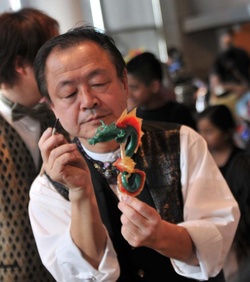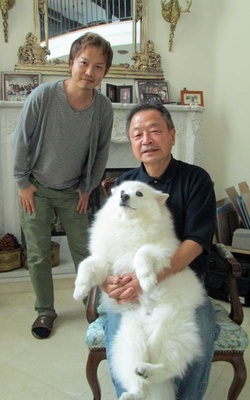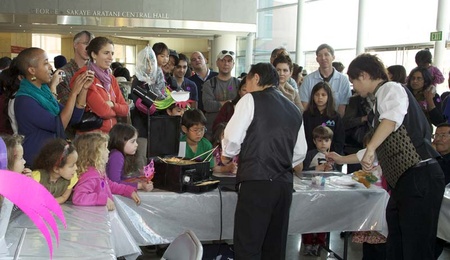Working His Way up from Swap Meets to Private Celebrity Parties
Amezaiku (candy crafts) is a piece of artistry which transforms soft candy into intricate shapes of animals and many other objects. While we can clearly picture its process in our head, we can’t quite remember whether we have seen it on TV or in real life—a possible proof of just how rare a traditional Japanese art of amezaiku has become.

Mr. Ichiyanagi making a candy sculpture at the Japanese American National Museum on January 2013. Photo by Daryl Kobayashi.
Currently based in Los Angeles, Shinobu “Shan” Ichiyanagi inspires America and the rest of the world as a candy artist—better known in English as “Candy man.” His reunion with amezaiku took place in America, not Japan, when he came to study abroad.
“In 1971, after high school graduation, I came to Los Angeles where my relatives lived. I made a Japanese friend at the adult school I attended at first to learn English. His name is Terasawa, who was about four years older than me. I was 18 at the time. One day he gathered his classmates at lunchtime and started performing amezaiku out of the blue. It brought the vivid scene of a stand in Sapporo from my childhood back to my memory. I was so touched by his performance that I asked him to take me as his apprentice.”
At first Ichiyanagi was planning to return to Japan and become a businessman after college graduation. However, as he discovered amezaiku in America and became a martial (karate) artist and had many pupils of his own, his initial desire of going back to his country gradually disappeared.
“I experienced my first marriage when I was about 22 or 23. My American wife’s mother’s husband was in marketing at Max Factor. When I showed him my amezaiku, he told me I could make a business out of it. He said I should perform at places like Disneyland or Magic Mountain.”
In fact, Terasawa, after working at Disneyland, was invited to Walt Disney World and moved his residence from Los Angeles to Florida. Ichiyanagi, on the other hand, was performing amezaiku at private parties of Hollywood celebrities and company events. Looking back, he says that it all started from small but dedicated performances he gave at swap meets.
“In the beginning I went around almost all swap meets in Southern California. I was sweating out making candies for 25 or 50 cents each, and one person approached me. I was like, please don’t distract me while I’m working, but this person asked me if I wanted to perform at celebrity parties.”
Thus began his career as Candy man. He was invited to perform at private parties of such celebrities as actress Shirley Jones from “The Partridge Family,” actor Charlton Heston, Michael Jackson, The Hilton family and was even asked to perform in front of Tom Bradley, who at the time was the mayor of Los Angeles when he was invited to the party where the officials from the L.A. Olympics passed on their duties to the representatives of the next host city, Seoul.
Performance Long Remembered To Be Transformed into Artwork That Retains in Shape
“Bar Mitzvah of Jewish families takes up large part of private parties. Wealthy Jewish people have a big celebration for this event. I get invited there and perform amezaiku in front of a large audience of guests. Kids would lean forward and look at it with their eyes sparkling in excitement. And then some decades later at a different event they would approach me and say, ‘I saw your candy performance long time ago’ which actually happens quite a lot.”
Ichiyanagi’s amezaiku is a kind of art that remains in one’s memory. Not only does he frequently head to New York to perform at events, most of which are Bar Mitzvah, but he also flies to Dubai with his travel costs all covered by his clients. During the off-season of Bar Mitzvah, he gets invited to perform at Nikkei summer festivals. Indeed, he is working on his amezaiku full-time, all year round. He says that he’s had more than 8,000 performances so far.
“Is there anything you cannot make?” on impulse I asked him a simple but straight question. “Today we have iPhones. As long as I can search it and see what it looks like, there is nothing that I cannot make,” said Ichiyanagi in a clear and firm tone. His ability to grasp objects so quickly is no doubt attributed to his daily training and years of experience.
I asked Ichiyanagi what is needed to become a candy artist. “Diligence to keep learning. Dedication and willingness to study and improve your skills. You need to be able to show how fun amezaiku is, have necessary skills and present your work beautifully. So I got a jewelry appraiser’s certificate when I was 30. I thought that the beauty of top-quality amezaiku and jewelry would have something in common. Now I use my appraisal skills to make beautiful artwork.”
Ichiyanagi wishes to transform amezaiku as a form of memorable art, as mentioned before, into a piece of artwork that lasts forever. “We can’t retain candy permanently. Some of my customers use sprays to preserve it, but there’s only so much it can do. I’m planning to work on this project where I would make the twelve animals of the Japanese zodiac, coat them with some material like gold for permanent preservation and put them on exhibition somewhere.”
Artistry in Its Perfection Continues to Shine Regardless of Changes in Time, Place and Audience

Ichiyanagi and his nephew Taka (in the back) who came to America from Hokkaido to learn candy crafts. Photo courtesy of Keiko Fukuda.
Even in America, he has seen other candy artists on some occasions. “Although they thrived at that moment, soon they disappeared,” says Ichiyanagi. “If we continue to improve and keep performing, I’m sure that possibilities will come on our way. I made candy crafts for Paris (Hilton) when she was just a baby and years later, she would invite me to her party. And what used to be a small company when they first called on me has made such a success and grown bigger, and they still remember me from the old days and ask me to perform for them again.”
Ichiyanagi continues to inspire American people with his amezaiku performance which has become a rare sight even in Japan. Since seven years ago, he has been rigorously training his nephew Taka to hand down his skills. “The training was so hard that I almost ran away once,” says Taka. But now he understands what it takes to acquire artistry of such value and will, and devotes himself to the training with strong determination.
Of course, Ichiyanagi himself is willing to continue his performance as long as he can. What keeps him motivated is one painting at the Metropolitan Museum of Art in New York. In the painting titled The Ameya by Robert Frederick Blum, there is an amezaiku artist making candies for kids on a street corner in Japan from the Meiji era. The kids have babies on their back, but their eyes are drawn to the hands of the artist with their bodies leaning forward. It’s the exact same scene at a Bar Mitzvah party where the guests watch Ichiyanagi’s performance so intently.
Despite changes in time, place and audience, there is nothing that can take away the enchantment of traditional art cultivated to such perfection. This painting, The Ameya, is the one that reminds Ichiyanagi, a professional with more than 40 years of experience, where his amezaiku all began.
* You can watch Ichiyanagi’s performances on YouTube:
http://www.youtube.com/watch?v=bo-2_4EMM1w
http://www.youtube.com/watch?v=J6PvErG0wgo
* * * * *
OSHOGATSU FAMILY FESTIVAL
Japanese American National Museum
Sunday, January 5, 2014 • 11AM – 5PM
FREE ADMISSION ALL DAY!
Ring in the New Year and the Year of the Horse with exciting cultural performances, special foods, and fun crafts!
Watch world-renowned candy artist Shan Ichiyanagi make his specialty horse candy sculptures (12-5pm)! (For children only: Candies will be raflled off throughout the day!)
© 2013 Keiko Fukuda









